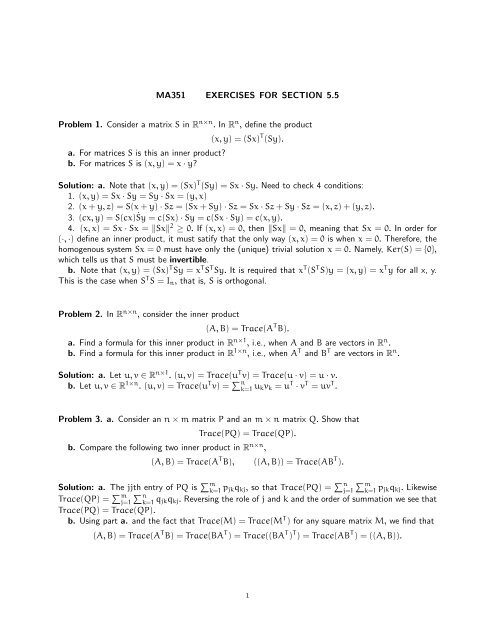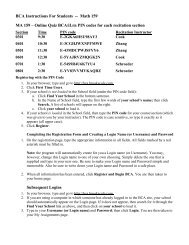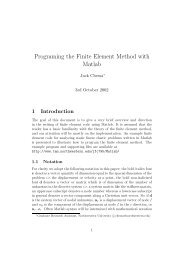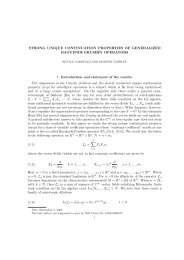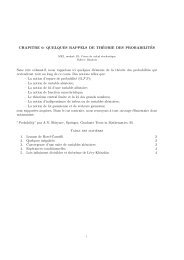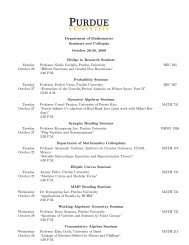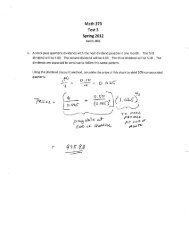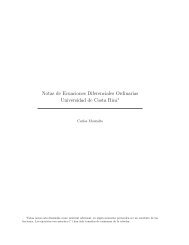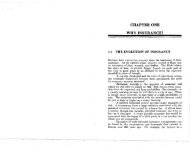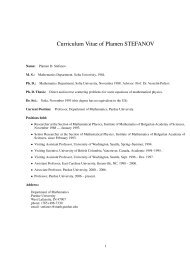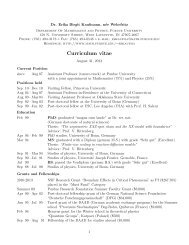(x, y)=(Sx)T
(x, y)=(Sx)T
(x, y)=(Sx)T
You also want an ePaper? Increase the reach of your titles
YUMPU automatically turns print PDFs into web optimized ePapers that Google loves.
MA351 EXERCISES FOR SECTION 5.5<br />
Problem 1. Consider a matrix S in R n×n . In R n , define the product<br />
a. For matrices S is this an inner product?<br />
b. For matrices S is (x, y) = x · y?<br />
(x, y) = (<strong>Sx</strong>) T (Sy).<br />
Solution: a. Note that (x, y) = (<strong>Sx</strong>) T (Sy) = <strong>Sx</strong> · Sy. Need to check 4 conditions:<br />
1. (x, y) = <strong>Sx</strong> · Sy = Sy · <strong>Sx</strong> = (y, x)<br />
2. (x + y, z) = S(x + y) · Sz = (<strong>Sx</strong> + Sy) · Sz = <strong>Sx</strong> · Sz + Sy · Sz = (x, z) + (y, z).<br />
3. (cx, y) = S(cx) ˙Sy = c(<strong>Sx</strong>) · Sy = c(<strong>Sx</strong> · Sy) = c(x, y).<br />
4. (x, x) = <strong>Sx</strong> · <strong>Sx</strong> = <strong>Sx</strong> 2 ≥ 0. If (x, x) = 0, then <strong>Sx</strong> = 0, meaning that <strong>Sx</strong> = 0. In order for<br />
(·, ·) define an inner product, it must satify that the only way (x, x) = 0 is when x = 0. Therefore, the<br />
homogenous system <strong>Sx</strong> = 0 must have only the (unique) trivial solution x = 0. Namely, Ker(S) = {0},<br />
which tells us that S must be invertible.<br />
b. Note that (x, y) = (<strong>Sx</strong>) T Sy = x T S T Sy. It is required that x T (S T S)y = (x, y) = x T y for all x, y.<br />
This is the case when S T S = In, that is, S is orthogonal.<br />
Problem 2. In R n×n , consider the inner product<br />
(A, B) = Trace(A T B).<br />
a. Find a formula for this inner product in R n×1 , i.e., when A and B are vectors in R n .<br />
b. Find a formula for this inner product in R 1×n , i.e., when A T and B T are vectors in R n .<br />
Solution: a. Let u, v ∈ R n×1 . (u, v) = Trace(u T v) = Trace(u · v) = u · v.<br />
b. Let u, v ∈ R 1×n . (u, v) = Trace(u T v) = n<br />
k=1 ukvk = u T · v T = uv T .<br />
Problem 3. a. Consider an n × m matrix P and an m × n matrix Q. Show that<br />
Trace(PQ) = Trace(QP).<br />
b. Compare the following two inner product in R n×n ,<br />
(A, B) = Trace(A T B), ((A, B)) = Trace(AB T ).<br />
Solution: a. The jjth entry of PQ is m k=1 pjkqkj, so that Trace(PQ) = n m j=1 k=1 pjkqkj. Likewise<br />
Trace(QP) = m n j=1 k=1 qjkqkj. Reversing the role of j and k and the order of summation we see that<br />
Trace(PQ) = Trace(QP).<br />
b. Using part a. and the fact that Trace(M) = Trace(MT ) for any square matrix M, we find that<br />
(A, B) = Trace(A T B) = Trace(BA T ) = Trace((BA T ) T ) = Trace(AB T ) = ((A, B)).<br />
1
2 MA 351 EXERCISES FOR SECTION 5.5 11/28/2011 YOLCU<br />
Problem 4.<br />
a. Consider the space P2 of polynomials of degree less than or equal to 2 with inner product<br />
〈f, g〉 =<br />
1<br />
0<br />
f(t)g(t) dt.<br />
Find a basis of the space W of all functions in P2 that are orthogonal to f(t) = t. What is the dimension<br />
of W?<br />
b. Consider the space P2 of polynomials of degree less than or equal to 2 with inner product<br />
(f, g) = 1<br />
2<br />
1<br />
−1<br />
f(t)g(t) dt.<br />
Find an orthonormal basis of the space of all functions in P2 that are orthogonal to f(t) = t.<br />
Solution: a. This one is similar to what is in b.<br />
b. A function g(t) = a + bt + ct2 is orthogonal to f(t) = t if<br />
0 = (f, g) = 1<br />
2<br />
1<br />
−1<br />
t(a + bt + ct 2 ) dt = 2<br />
3 b.<br />
meaning that b = 0. Thus, g(t) = a + ct2 belongs to span{1, t2 } = W. That is, 1 and t2 form a basis<br />
of the space W of all functions in P2 orthogonal to f(t) = t. To find an orthonormal basis {g1(t), g2(t)}<br />
we apply Gram-Schmidt. Now,<br />
1 2 = (1, 1) = 1<br />
1<br />
1 dt = 1<br />
2 −1<br />
so we can take g1(t) = 1 as 1 = 1. Also,<br />
g2(t) = t2 − (1, t2 )1<br />
t2 − (1, t2 )1 = t2 − 1<br />
3<br />
t2 − 1<br />
√<br />
5<br />
=<br />
3 2 (3t2 − 1).<br />
√<br />
5<br />
Therefore, {g1(t), g2(t)} = {1, 2 (3t2 − 1)} is an orthonormal basis for W. Moreover dim(W) = 2.<br />
Problem 5. Which of the following is is an inner product in P2? Explain.<br />
a. (f, g) = f(1)g(1) + f(2)g(2)<br />
b. ((f, g)) = f(1)g(1) + f(2)g(2) + f(3)g(3)<br />
Solution: a. (f, g) is not an inner pruduct in P2 because f(t) = (t − 1)(t − 2) implies (f, f) = 0 but<br />
f = 0.<br />
b. ((f, g)) is an inner product, and easy to check the four axioms. Note that ((f, f)) = f(1) 2 +<br />
f(2) 2 + f(3) 2 = 0 when f(t) = 0 in P2, because any polynomial in P2 has at most 2 zeros. That is, if f<br />
were nonzero polynomial, then at least one of f(1), f(2) and f(3) would be nonzero and ((f, f)) would<br />
be strictly positive.
MA 351 EXERCISES FOR SECTION 5.5 11/28/2011 YOLCU 3<br />
Problem 6. For which values of the constants b, c and d is the following an inner product in R2 ?<br />
<br />
x1 y1<br />
, = x1y1 + bx1y2 + cx2y1 + dx2y2<br />
x2<br />
y2<br />
Solution: Using the four axioms, one can obtain b = c and d > b 2 . Work out the details!<br />
Problem 7. a. Find an orthonormal basis of the P1 with the inner product<br />
(f, g) =<br />
1<br />
0<br />
f(t)g(t) dt.<br />
b. Find the linear polynomial g(t) = at + b that best approximates the function f(t) = t 2 on the<br />
interval [0, 1] in the least-squares sense. Draw a sketch.<br />
Solution: a. We start with the standard basis {1, t} and use the Gram-Schmidt process to construct an<br />
orthonormal basis {g1(t), g2(t)}. Note that<br />
so that we can let g1(t) = 1. Then<br />
g2(t) =<br />
1 2 = (1, 1) =<br />
t − (t, 1)1<br />
t − (t, 1)1<br />
1<br />
0<br />
1 dt = 1<br />
= t − 1<br />
2<br />
t − 1<br />
2 = √ 3(2t − 1).<br />
Therefore, {g1(t), g2(t)} = {1, √ 3(2t − 1)} is an orthonormal basis of P1.<br />
b. We are looking for<br />
Note that<br />
Therefore,<br />
(t 2 , g1(t)) =<br />
projP1 (t2 ) = (t 2 , g1(t))g1(t) + (t 2 , g2(t))g2(t).<br />
1<br />
0<br />
t 2 dt = 1<br />
3 , (t2 , g2(t)) =<br />
projP1 (t2 ) = 1<br />
3 +<br />
√ 3<br />
6<br />
1<br />
0<br />
t 2√ 3(2t − 1) dt =<br />
√ 3(2t − 1) = t − 1<br />
6 .<br />
√ 3<br />
6 .
4 MA 351 EXERCISES FOR SECTION 5.5 11/28/2011 YOLCU<br />
Problem 8. Consider the inner product<br />
(u, v) = u T<br />
<br />
1 2<br />
v, u, v ∈ R<br />
2 8<br />
2 .<br />
a. Find all vectors in R2 <br />
1<br />
that are perpendicular to with respect to the inner product defined<br />
0<br />
above.<br />
b. Find an orthonormal basis of R2 with respect to this inner product.<br />
c. Is the following inequality true? Explain why.<br />
(u1v1 + 2u1v2 + 2u2v1 + 8u2v2) 2 <br />
≤ (u1 + 2u2) 2 + 4u 2 <br />
2 (v1 + 2v2) 2 + 4v 2 <br />
2 .<br />
<br />
<br />
x1 1<br />
−2<br />
Solution: a. , = x1 + 2x2 = 0 when x1 = 2x2. This is the line spanned by vector .<br />
x2 0<br />
1<br />
<br />
1 −2<br />
b. From part a. we noticed that and are orthogonal, we merely have to normalize them.<br />
0 1<br />
Note that<br />
<br />
<br />
<br />
1 <br />
0<br />
2<br />
= 1 0 1 2<br />
2 8<br />
<br />
1<br />
= 1,<br />
0<br />
<br />
<br />
<br />
−2 2<br />
=<br />
1<br />
−2 1 <br />
1 2 −2<br />
= 4.<br />
2 8 1<br />
<br />
1 −1<br />
Thus, , is an orthonormal basis for R<br />
0 1/2<br />
2 with respect to the inner product defined above.<br />
c. From (tu + v, tu + v) = tu + v2 ≥ 0 for all t, we see that t2 (u, u) + 2t(u, v) + (v, v) ≥ 0<br />
holds true for all t. Recall that the discriminant b2 − 4ac ≤ 0 when at2 + bt + c ≥ 0. Therefore, we<br />
get |(u, v)| 2 ≤ (u, u)(v, v). It remains to verify that the inequality claimed in part c is as the same as<br />
|(u, v)| 2 ≤ (u, u)(v, v). Therefore, the answer is YES.<br />
Problem 9. In the space P1 of the polynomials of degree ≤ 1, we define the inner product<br />
(f, g) = 1<br />
(f(0)g(0) + f(1)g(1)) .<br />
2<br />
Find an orthonormal basis for this inner product space.<br />
Solution: We start with the standard basis {1, t} of P1 and use the Gram-Schmidt process to construct<br />
and orthonormal basis {g1(t), g2(t)}. Note that<br />
so that we can let g1(t) = 1. Then<br />
1 2 = (1, 1) = 1<br />
(1 · 1 + 1 · 1) = 1,<br />
2<br />
g2(t) =<br />
t − (t, 1)1<br />
t − (t, 1)1<br />
= t − 1<br />
2<br />
t − 1<br />
2<br />
= 2t − 1.<br />
Summary: The functions g1(t) = 1 and g2(t) = 2t − 1 form an orthonormal basis for P1.
MA 351 EXERCISES FOR SECTION 5.5 11/28/2011 YOLCU 5<br />
Problem 10. Consider the linear space of all polynomials with inner product<br />
(f, g) =<br />
1<br />
0<br />
f(t)g(t) dt.<br />
For three polynomials f, g, and h we are given the following inner products:<br />
(f, f) = 4, (f, g) = 0, (f, h) = 8, (g, g) = 1, (g, h) = 3, (h, h) = 50.<br />
a. Compute (f, g + h).<br />
b. Find g + h.<br />
c. Find projW(h), where W = span{f, g}, interms of f and g.<br />
d. Find an orthonormal basis of span{f, g, h} in terms of f, g and h.<br />
Solution: a. (f, g + h) = (f, g) + (f, h) = 8.<br />
b. g + h2 = (g + h, g + h) = (g, g) + 2(g, h) + (h, h) = 57 imples g + h = √ 57.<br />
c. Note that (f, g) = 0, g = 1 and f = 2. Therefore, { 1<br />
2f, g} is an orthonormal basis for W.<br />
Thus,<br />
<br />
projW(h) = h, f<br />
<br />
f<br />
+ (h, g)g = 2f + 3g.<br />
2 2<br />
d. We already know that {g1 = 1<br />
2f, g2 = g} is an orthonormal basis for W. To find an orthonormal<br />
basis of span{f, g, h} in terms of f, g and h we need to obtain the third polynomial:<br />
g3 =<br />
h − projW(h) h − 2f − 3g<br />
=<br />
h − projW(h) 5<br />
Thus, an orthonormal basis of span{f, g, h} is<br />
{g1, g2, g3} =<br />
1<br />
2<br />
f, g, −2<br />
5<br />
= − 2<br />
5<br />
3 1<br />
f − g +<br />
5 5 h<br />
<br />
.<br />
3 1<br />
f − g +<br />
5 5 h.


